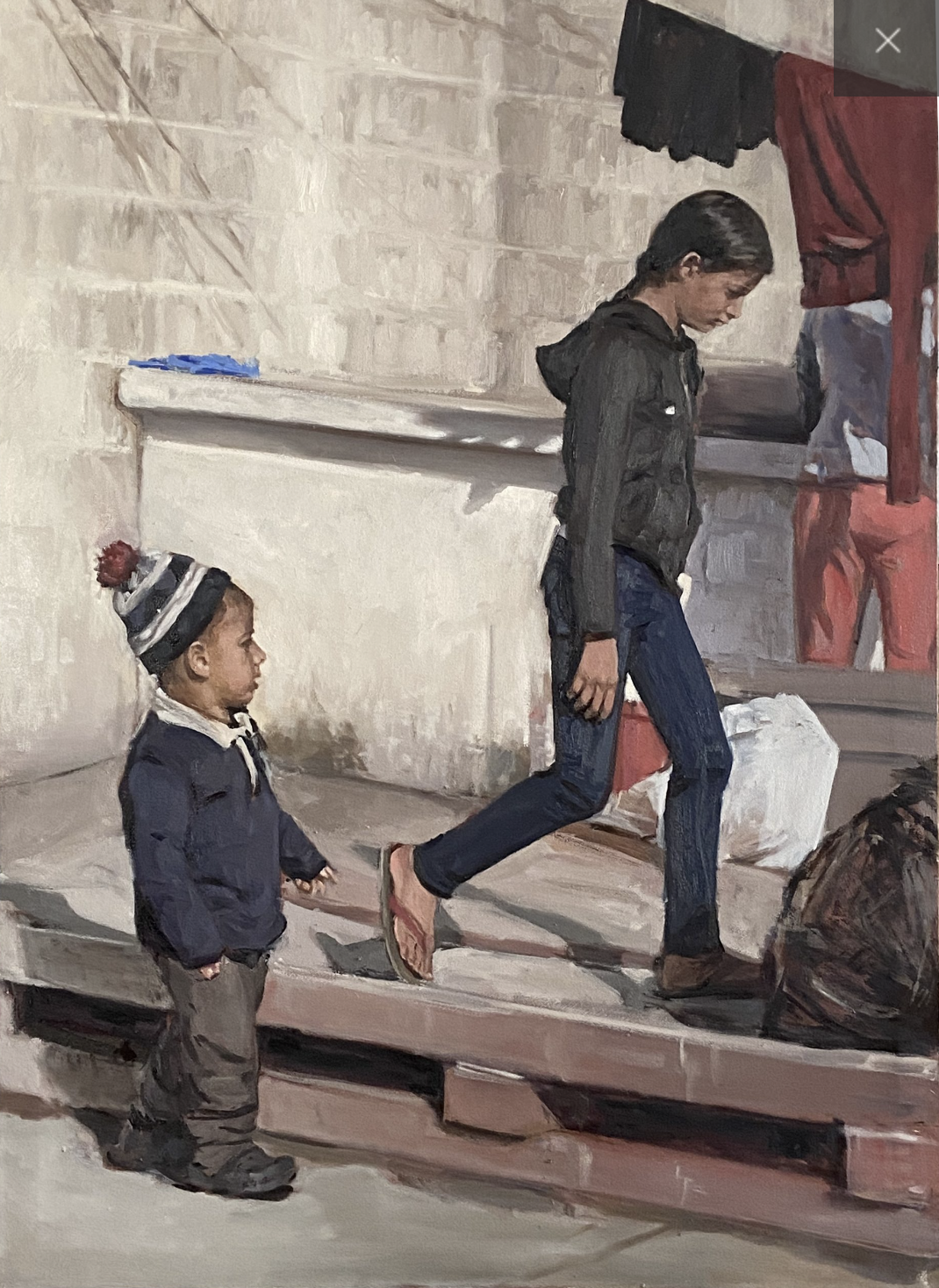An Interview With Adrian Aguirre
Aimee Resnick (she/her) - June 15, 2023
Adrian Aguirre is a Mexican-American artist who creates nuanced portraits of immigrant communities. Born at the border of Juárez and El Paso, Aguirre learned at an early age to “love two cultures.” This duality is a central theme of Aguirre’s work; in his paintings, he explores human transmigration, intergenerational power, and universal humanity. Shadowing immigrant job sites, Aguirre captures unromantic, pure moments in workers’ day-to-day lives. This week, we sat down to discuss border policy, documentary art, and the colonial horse.
NAR: Tell me about your experiences as a youth crossing the border between El Paso and Juarez to attend school. What is your most striking memory from this routine?
Aguirre: It's probably strange for most people to think about: we would wake up very early and my mom would take my brothers, my cousins, and I across the border. It would take at least an hour on most days. We would do our homework in the car.
My most harrowing memory is a misunderstanding at the movies. We used to see movies in El Paso because they would get released in English before they would get released in Mexico. As we were crossing the border, they thought that I was living illegally in the United States. So they brought me into an interrogation room and questioned me. I was maybe 11 or 12 years old.
Lavabos El Barretal, from the series Migrantes. 2020. Oil on canvas. 48 x 34”.
It was pretty scary. Of course, I was able to get out of it because I wasn't doing anything wrong. But it’s a striking memory. It was assumed that I was guilty before proven innocent. I didn't have any power compared to immigration officials. I was a child in the room with an adult.
I'm a citizen now, so my situation is different. But in my current work, many immigrants relate to how I felt in that interrogation room. I just felt powerless. We experience a lot of patronization and unnecessary force.
NAR: As American immigration policy has become increasingly draconian, how have interactions with immigration officers changed?
Aguirre: I always come back to power dynamics. When I think about modern immigrants, they just don't have the same legal rights as everybody else.
Just recently, they rounded up a lot of Venezuelan and Central American immigrants in Juarez. The immigration officials in Mexico are corrupt. They seize immigrants who don’t have agency: they don't have the paperwork to fight back. They can just be taken and extorted for money.
In the United States, there's definitely the idea that officers are there to protect the United States. Organized crime does exist, and it exists on both sides of the border. There's human trafficking and all sorts of things. There is some danger.
But I think that the use of powerful weapons in border defense is definitely unnecessary. It’s not designed to deal with our humanitarian crisis. We could use our resources more efficiently than to detain refugees in private prisons. We need to find a way to process immigrants in a way that's humane while also making sure that dangerous criminals don’t pass through.
NAR: Often, immigrants and refugees are portrayed as criminals. How does this inform your portraiture?
Aguirre: There’s this persistent idea that anybody who crosses the border is doing so illegally. But the majority of recent immigration claims are from people that are seeking asylum. It’s a legal process. But these refugees are being called illegal. People are saying it's illegal migration.
Sombras, from the series Jornaleros.
Part of the problem is that existing policies prevent safe immigration. So people can’t utilize legal entry points. Instead they scale a wall or climb a fence. And then they have to turn themselves in so they can claim asylum post-entry. That certainly doesn't help with the perception that immigrants are doing something illegal. But that’s the only way that they can come here and claim asylum. Outside of that, there are no legal ways.
Our immigration system is designed to prevent poor people from entering. It’s by design that poor people are only allowed to enter through precarious means. It’s intended to keep poor people working at a lower pay. It’s cyclic poverty de jure.
I think it's really hard for me to think about that in my art because I don't see them as criminals. I just see people that are trying to survive. As an artist, I try to emphasize that immigrants are just people. I do that primarily with portraiture; I capture their moment. When somebody looks at the painting, they can relate to them and imagine themselves in their position. That empathy is how we can change policy.
Lunch Truck, from the series Jornaleros. 2008. Oil on canvas. 42 x 96”.
NAR: What narrative script of the immigrant do you want to impart?
Aguirre: You know, I just want The Immigrant to be something that anybody can relate to. I don't like spontaneous portraiture: it feels too much like documentary photography. There's a fine line between illustrating immigrants accurately while making sure they feel good about the way they're being portrayed.
Most of my portraits are made using reference photographs. I take the photos on site and show the images to my subjects for approval. They have to like how they're being seen.
Chente, from the series Jornaleros. Charcoal, 40 x 60” .
NAR: Tell me about Jornaleros. How do migrant workers respond to your presence? How does it feel to occupy these spaces?
Aguirre: I usually wait awhile before I ask to paint them. It’s not brought up until after I talk to them for a little bit and tell them who I am and what I'm trying to do. For the most part, they're open to it. Most of the time they react positively.
After that, I start by offering them to draw a portrait on site. You know, just in my sketchbook. I give it to them and then I ask to take their photograph.
NAR: Have you ever reconnected with someone whose portrait you’ve painted?
Aguirre: Yeah, actually. When I painted day laborers in Texas, I went back and showed them some of the work that I did in my studio. I actually asked them to attend my show. I don't think that they ever were planning on going, but they reacted positively to my invitation.
Manman ak pitit fi, from the series Patrol. Oil on paper mounted to board. 60 x 46”.
NAR: Tell me more about your use of the horse as a symbol for power in Patrol. From where does this power derive? What are the colonial implications of this inequality?
Aguirre: For me, the horse is a huge part of my work. I was just struck by the horse of power. Of simple unnecessary power. The police were chasing kids who were trying to cross the river on horseback. It was an incredible contrast of power.
There's a lot of history there. There's a history of border patrol using horseback. It’s a recognizable image in El Paso. At the El Paso airport, there's a huge mural of a border patrol agent on horseback. There's even a border patrol museum in El Paso with a huge sculpture of border patrols on horses.
Even more, there’s a history of horses being used by colonizers in Mexico and other Latin American countries. There’s the history of slave patrols in the American South. There's many histories of oppression associated with the horse.
They're on a literal high horse. The horse is a powerful animal.
Patwouy Cheval. 2022. Oil on canvas. 22 x 28”.
NAR: How can art serve as an informative documentary? Can painting ever be a fully truthful media outlet? How can paintings function with objectivity while retaining the subjective charm of art?
Aguirre: I want to present things as they are without overly romanticizing things. It’s important to me that my art is based in reality. Some artists treat their canvas as a stage; they paint theatre scenes of immigrants crossing the border. There's nothing wrong with dramatism, but I'm more interested in showing something that's actually happening.
I don't know if objectivity exists. Everything is subjective. I'm not interested in recreating the objective; I don't think that's possible.
Obviously, I have an agenda as an artist, but I've come to learn what strategically works best. If you create a piece that’s too propagandistic or too didactic, people shut down. So I try to create work that's open-ended. Art doesn’t need to hit you over the head.
Detenido, from the series Patrol. Charcoal and gouache on paper. 38 x 50”.
NAR: If you could reform immigration policy overnight, what changes would you make?
Aguirre: We must treat immigrants more humanely. Immigration is tied to foreign policy. There's a reason why so many Venezuelans are immigrating right now: it's because the United States put sanctions in place to disrupt the economy. The same thing happened to Cuba.
The United States has been involved in overthrowing governments to destabilize the region. Any changes to immigration policy must be paired with changes to foreign policy. We need to help people stay in their home countries by improving Latin America.
Most immigrants are forced to leave their home country. No one wants to leave their country. Everybody would like to stay in their home. We need to improve people’s homes.
We also must eliminate the unjust extortion of immigrants. Many people come to the United States with nothing. This places them at high risk. They are very vulnerable. Regardless of one’s financial situation, they must be given the same worker’s protections as citizens.
Please note: this interview has been edited for length and clarity.








